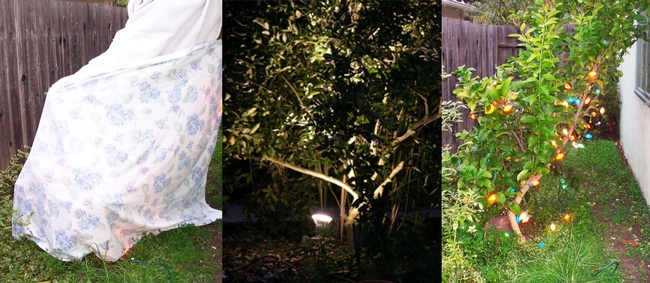By Michele Carter, Butte County Master Gardener, January 2, 2015
Winter has finally arrived in the north state! Winter temperatures can pose a threat to the fruit and foliage of citrus, as well as other succulents, tender perennials, tropical and subtropical plants.
The most common type of frost in California is referred to as radiation frost. Radiation frost occurs on cold nights when the air is clear and still. Soil, buildings, plants, and other objects at the earth's surface act as a heat reservoir by absorbing heat during the day. Heat is lost, or radiated, from the earth's surface into the atmosphere and plants are damaged when enough heat is lost from this reservoir to lower the temperature at the surface to below critical temperatures. Greater damage occurs with colder temperatures or a longer duration of cold. Temperatures can drop more rapidly when the air is very dry and the dewpoint is low. If the dewpoint is very low a freeze can occur without the formation of dew and frost. This condition is known as a “black frost.”
Avoid planting frost-sensitive trees in the lowest areas of the yard or garden, as cold air tends to flow downhill and can accumulate in such depressions. Trees planted near structures or walls, particularly those with southwest exposure that absorb and retain reflected heat during the day, may be damaged less during periods of frost because that heat is released during the night. Fertilize and prune during the spring and early summer so that new foliage will have enough time to mature before the onset of cold weather. Bare, moist soil stores more heat during the day and radiates more heat during the night, so rake away mulch, ground cover, weeds and leaves from around the tree during cold weather.
Monitor weather forecasts and take note of how low temperatures will go, and for how long. When the weatherman warns of frost, there are several precautions you can take to protect your plants.
- Identify cold spots in your landscape by monitoring with thermometers
- Identify plants at risk: citrus, succulents, tender perennials, tropical & subtropical plants
- Have supplies ready: either sheets or blankets with stakes or a framework to hold covers off foliage, or frost cloth (which can lie directly on plant foliage); lights; wraps for trunks; thermometers.
- Wrap trunks of tender trees, using towels, blankets, rags or pipe insulation.
- Move potted plants to warmer spots next to the house or under a patio cover.
- Water plants and trees. Dry plants are more susceptible to damage and moist soil retains heat better than dry soil.
- Cover plants just before sunset to capture and hold in as much heat as possible. Remove sheets/blankets daily if it's sunny, to allow soil to absorb heat during the day.
- Add heat by hanging a 100-watt lamp designed for outdoors in the interior of the tree, or use a holiday string of outdoor lights (not LED lights, since they don't give off heat).
If a tree's or plant's larger branches sustain frost damage, don't prune away damaged wood or remove the plant too soon. Wait several months in order to assess the extent of the damage and allow time for possible recovery during warm weather. As new foliage begins to grow, frost-killed twigs and branches will be apparent and can be pruned at that time. Postpone heavy pruning until the following year to allow trees to regrow to the point where damaged wood can be clearly determined.
For more information visit the ANR Catalog, publication 8100 (Frost Protection for Citrus and Other Subtropicals).
